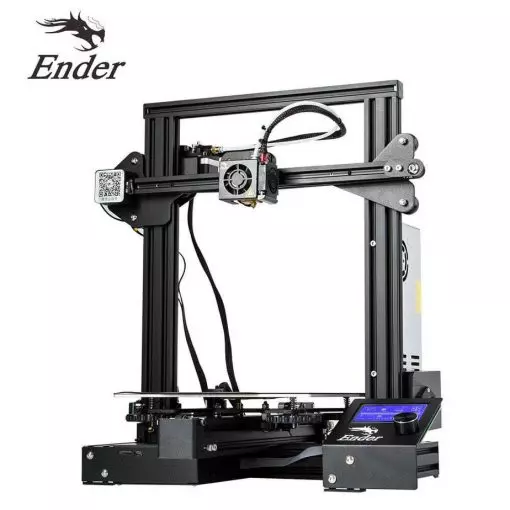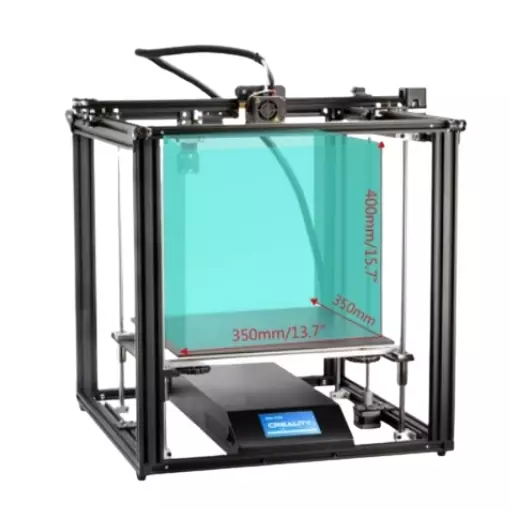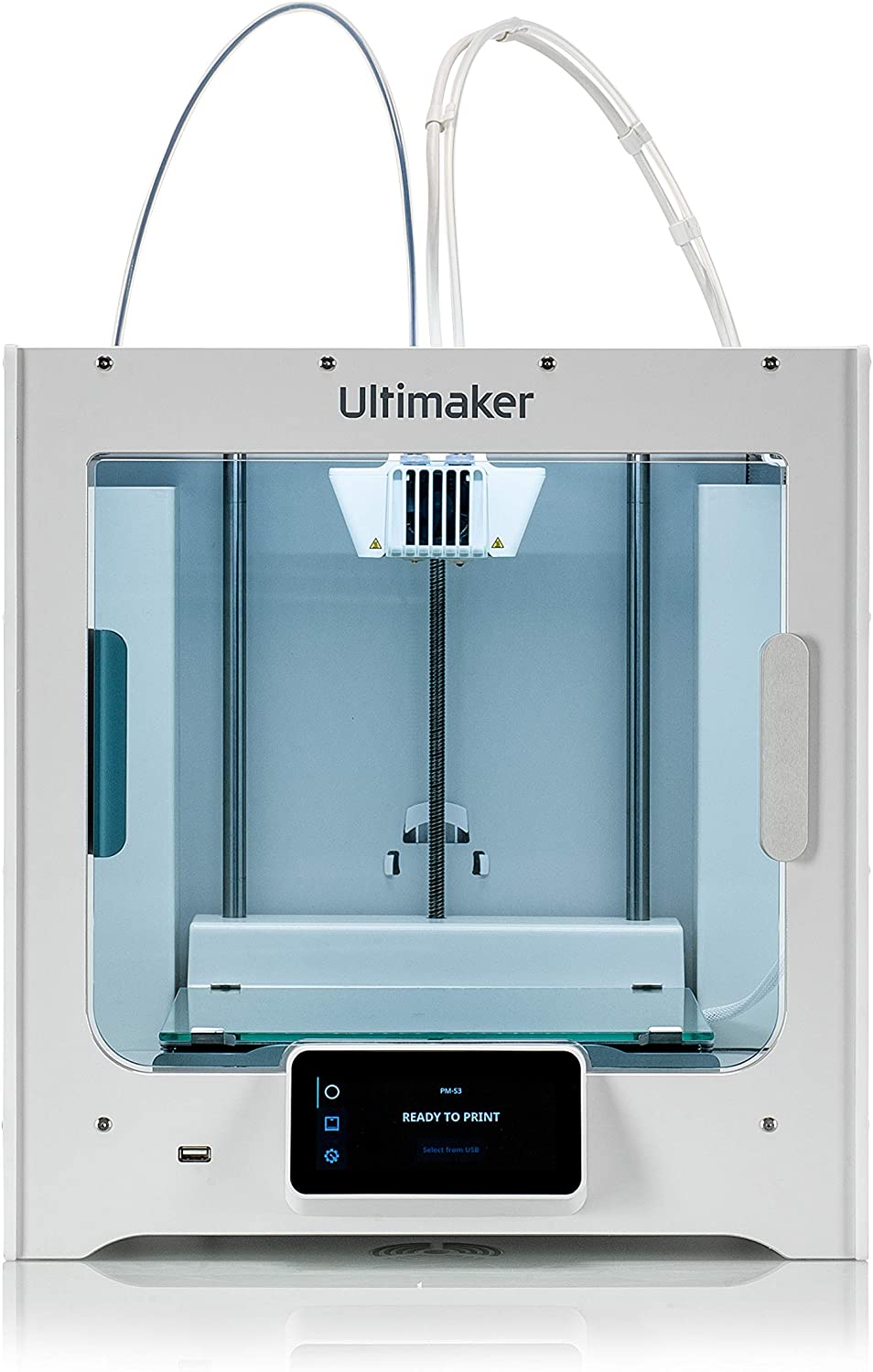Compare Ender 3 vs Ender 5 Plus vs S5
Comparison between the best 3D printers
Choose the best 3D printer at the best price. The cheapest 3D printers are here.
Buy a 3D printer here with 3D Fila.
 |
 |
 |
|
| Model | Ender 3[BUY Ender 3] |
Ender 5 Plus[BUY Ender 5 Plus] |
S5 |
| Printing Material | Filament | Filament | Filament |
| Estimated price | $210,00 | $599,00 | $6950,00 |
| Fabricante | Creality 3D | Creality 3D | Ultimaker |
| Release Year | 2018 | 2019 | 2021 |
| Print Volume [mm] | 220x220x250 | 350x350x400 | 330x340x300 |
| Printer Size [mm] | 440x440x465 | 632x619x666 | 495x585x780 |
| Weight [kg] | 6,62 | 18,2 | 20,6 |
| Power Loss Recovery | NO | YES | YES |
| Enclosed printer | NO | NO | NO |
| Bed Leveling | Manual | Automatic | Automatic |
| Filament End Sensor | NO | YES | YES |
| Bed type | Heated | Heated | Heated |
| Power supply system | Bowden | Bowden | Bowden |
| Standard nozzle | 0,4 | 0,4 | 0,4 |
| Maximum Nozzle Temperature [°C] | 255 | 260 | 280 |
| Maximum Bed Temperature [°C] | 110 | 100 | 140 |
| Maximum printing speed [mm/s] | 180 | 180 | 80 |
| Filament holder | YES | YES | YES |
| Camera for supervision | NO | NO | YES |
| Recommended filaments | PLA, TPU, ABS, PETG | PLA, TPU, ABS, PETG | PLA, ABS, PETG, PC, Nylon, Tritan |
| Recommended slicers | Cura, Simplify, Slic3r | Cura, Simplify, Slic3r | Cura |
| Maximum Resolution [mm] | 0,1 | 0,1 | 0,1 |
| Processor | 8 bits | 32 bits | |
| Display | Mono | Touchscreen TFT 4,3'' | Display touchscreen 4,7'' |
| Power Supply | 24V / 270W | 24V / 504W | 110/220V / 500W |
| Connectivity | SD / USB | SD / USB | USB / Wi-Fi |
| Operating systems | Windows, Mac, Linux | Windows, Mac, Linux | Windows, Mac, Linux |
| Date of registration in the system | 2021-04-13 | 2021-04-14 | 2022-11-08 |
| Release date | 2018 | 2019 | 2021 |
| Extra features | The Ender 3 V1 is a DIY assembly 3D printer, a sales leader since 2017, standing out for its cost-benefit. With a wide printing capacity, it has a CNC machined structure for precision and stability. It offers high-precision prints with low noise, thanks to its innovative V-profile and pulleys. It has a self-adhesive magnetic platform for easy removal of models and excellent adhesion. The Ender 3 heats up quickly, reaching 100°C in 5 minutes, ideal for agile prints. It includes protection against power failures, allowing you to resume printing after interruptions, saving time and material. | The Ender 5 Plus offers a large print volume (350x350x400 mm) and fast assembly. It includes a BLTouch sensor, but with range limitations. It stands out for its dimensional accuracy, although it requires adjustments to the slicer settings. Despite the noise, its integrated design saves space, and includes features such as a filament sensor and power resumption. Ideal for large projects, it requires refinement in the settings for high-quality prints. | The Ultimaker S5 stands out for its easy loading and unloading of materials, automatic bed leveling and excellent print quality with resolutions from 60 to 400 microns. It has dual extruders, interchangeable print cores, advanced connectivity with Wi-Fi and LAN, and intuitive software. It includes a Wi-Fi camera for monitoring, a removable glass bed, and a large build volume, making it ideal for professional and creative environments. |
| Support for multiple colors and materials (AMS and CFS) | NO | NO | NO |
Notes * |
|||
| Cost-benefit | 6 / 10 | 6 / 10 | 2 / 10 |
| Hardware | 0.5 / 10 | 2 / 10 | 3.6 / 10 |
| Screen | . | . | . |
| Print volume | 3 / 10 | 4 / 10 | 4 / 10 |
| Performance | 1 / 10 | 1 / 10 | 1 / 10 |
| [BUY Ender 3] | [BUY Ender 5 Plus] |
Conclusion |
| In comparing the three 3D printers—Ender 3, Ender 5 Plus, and Ultimaker S5—several significant factors emerge which can guide potential buyers in making an informed decision. The **Ender 3** offers an excellent balance of affordability and functionality, making it a highly accessible option for beginners and hobbyists. Its simple assembly, decent print volume, and adequate range of compatible materials present a strong cost-benefit ratio, making it suitable for those looking to experiment without a substantial financial commitment. However, it lacks advanced features such as power recovery and automatic bed leveling, which may necessitate manual intervention for users. The **Ender 5 Plus** improves upon the Ender 3 by offering a larger print volume and enhanced features such as automatic bed leveling and filament sensors. While it requires careful adjustment of slicer settings for optimal output, it caters well to larger projects. Yet, the increased price raises its overall cost-benefit score, which reflects a reasonable trade-off between cost and added functionality but still places it beneath the Ultimaker in terms of performance features. On the other hand, the **Ultimaker S5** is a professional-grade printer that commands a significantly higher price point but justifies it with advanced features including dual extruders, automatic bed leveling, and superior connectivity options. It caters to professional users who demand high print quality and reliable performance, alongside advanced monitoring features through its Wi-Fi camera capability. However, for casual users or those on a budget, its pricing may seem prohibitive without the necessity of its advanced functionalities. In conclusion, if budget constraints are a primary concern, the **Ender 3** is the clear winner, providing excellent value for its cost. For users willing to invest a bit more for enhanced capabilities and larger builds, the **Ender 5 Plus** is a sensible choice. Conversely, serious professionals or businesses requiring first-rate performance should consider the **Ultimaker S5**, recognizing that the investment promises significant dividends in print quality and reliability. Each of these printers serves diverse needs, thus the best choice ultimately hinges on the specific requirements of the user. |

